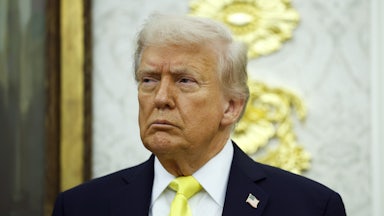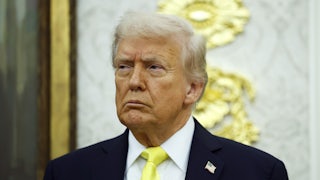It’s tempting to blame the late Joe Lieberman for this mess.
Over the weekend, customers on the health insurance marketplaces around the country began shopping for insurance plans for next year. There was likely some sticker shock. On average, premiums have risen 26 percent, but some people will be expected to pay thousands more because the enhanced subsidies enacted during the Covid pandemic are set to expire, leaving more people without financial help to purchase plans.
Congress is still wrangling over a solution to this problem for next year, which is why the government has been shut down for a month. But some of today’s problems might have been avoided—or at least dampened—if lawmakers had chosen a different path when negotiating over the Affordable Care Act some 15 years ago.
Democrats, who had a ruling trifecta in Washington at the time, let that chance get away from them. Will they act differently if they have the same opportunity in the future?
As a candidate, President Barack Obama promised to reform the health care system, something Democrats had wanted to do for generations. His proposals ultimately included many things that became part of the Affordable Care Act and one gigantic component that didn’t: the creation of a federal health insurance plan for people without access to Medicare or Medicaid. The plan, which customers could buy no matter where they lived or whether they had a job, would compete against private insurance in the marketplace. The idea became known as the public option.
Even before Obama was sworn in, though, other Democrats began staking their claim on health care reform. On the more liberal side was Massachusetts Senator Ted Kennedy, chair of the Committee on Health, Education, Labor, and Pensions, who included a public option in his committee’s proposal. “If you like the insurance you have today, you can keep it. If you don’t like what you have today, we’ll give you better choices, including a public option for health care,” Connecticut Senator Chris Dodd, who was also on the committee, said at the time. On the more conservative side, Montana Senator Max Baucus, chair of the Finance Committee, did not include a public option in his plan but did propose a more modest Medicaid buy-in for people age 55 to 64.
A public option might have had the effect of reducing premium costs, especially in the beginning. That’s because the government would have had the power to negotiate much lower payments to hospitals and doctors because they would insure so many patients and be such a big player. That is how Medicare and other public insurance programs cut costs now. But competing with a private option may also have led insurers to reduce premiums in the beginning too.
After a year of wrangling in the two committees and the whole Senate, the public option had a few deaths and resurrections. Obama championed it, and the Democrats had a 60-seat majority in the Senate. But that majority included Connecticut Senator Joe Lieberman, who caucused with the Democrats but was a more centrist independent, and he threatened to filibuster with Republicans if the bill contained a public option. It was struck from the final bill.
The ACA as passed was a fundamentally conservative law. While it attempted to control costs, premiums kept growing. And even with its subsidies for lower-income people, many Americans continued to struggle to afford good plans.
The issue remained a top one for Democrats. In the party’s 2019 primary, Joe Biden promised to strengthen the ACA and even resurrected the public option idea. “The first thing I would do as president ... we’re going to eliminate all the changes that this administration made trying to kill Obamacare, number one, and we’re going to add to it a public option,” he said on the trail.
Once he was in office, however, it disappeared again—even though Democrats again had a trifecta, albeit not a filibuster-proof margin in the Senate. There are likely many reasons they didn’t pursue the public option, but a big one is that doctors and hospitals oppose it. “In recent years, when public option proposals have bubbled up … health care provider groups have mobilized pretty strongly against them,” said Matthew Fiedler, a senior fellow at Brookings. That’s for the very same reason a public option would be cheaper: It would save money by paying providers less.
Instead of a public option, Biden used emergency legislation during the pandemic to create enhanced Obamacare subsidies, which made ACA plans more affordable for a broader range of people. These subsidies are expiring at the end of the year, which is the reason premiums for next year have shot up. It’s also why the government is shut down: Republicans refuse to extend the enhanced subsidies, so Democrats won’t vote for a continuing resolution to fund the government.
Fiedler cautioned that a public option might have controlled premium prices initially, but much of the growth in recent years has been driven by increased use of health care—there was a rebound after the pandemic ended—as well as by increased costs of medicines and other economic factors. The premium increases that people shopping for health care are already seeing are because insurers are trying to take into account the likelihood that healthier people will drop out of the marketplace if they lose the enhanced subsidies, leaving the risk pool of those covered by insurance sicker and more expensive.
A public option would have given Americans an alternative to private insurers, and it likely would have been more affordable. That would, without a doubt, have changed the way Americans access health care. At the time, conservatives opposed the public option, calling it a “Trojan horse” for universal public health care. It’s always been true that progressives want a more robust role for the government in providing health insurance—for the sensible reason that it works very well in most other developed countries, and for the moral reason that health care should be a human right, as opposed to something that is only (somewhat) affordable if you have a job with the right employer. Had Democrats managed to pass a half-measure like the public option, its popularity may have created more political support for the real thing: Medicare for All.
Where things stand today, with Republicans running Washington, even a public option looks like a long shot. But the Democrats know what it’s like to go from fully out of power after a presidential election to fully in power after the following one. That’s what happened in 2008, and it could well happen again in 2028. Will the Democrats be ready? And will they have the courage to finally fix the American health care system once and for all?






